Although the foundations of blockchain technology have been in development for decades, it only entered our lives as a functional product with the launch of Bitcoin in 2008. This groundbreaking innovation brought together cryptography, decentralization, peer-to-peer network communication, and transaction processes to usher in a new era in the digital world. However, the next evolution of this revolution was shaped by a vision proposed by Vitalik Buterin in 2013: Ethereum. Available since 2015, Ethereum aimed to go beyond being just a digital currency, offering a platform for decentralized applications (dApps) and smart contracts. So, what exactly is Ethereum (ETH), how does it work, and why is it so important? Here's everything you need to know about Ethereum…
What is Ethereum? How and Why Did It Emerge?
Ethereum (ETH) is fundamentally a decentralized application platform. Unlike Bitcoin, which focuses solely on financial transactions, Ethereum was designed as a programmable blockchain where developers can build various decentralized applications. At the heart of this platform are smart contracts, where the terms of an agreement are directly written into code lines and executed automatically.
Vitalik Buterin played a key role in the creation of Ethereum. Born in Russia and later moving to Canada with his family, Buterin had a strong interest in mathematics and programming from a young age. After his father introduced him to Bitcoin in 2011, Buterin became deeply inspired by the concept of a decentralized currency. However, as he became more involved in the Bitcoin community, he realized that Bitcoin had limitations in terms of flexibility and application diversity. So, when did Ethereum launched? Bitcoin's complex scripting language, lack of adaptability, and scalability issues prompted Buterin to seek a new solution.
As a result of this search, he published the whitepaper outlining Ethereum's core vision in 2013. This whitepaper envisioned a blockchain that could not only facilitate money transfers but also run decentralized applications with complex logic. Buterin chose the name Ethereum, referencing the hypothetical medium “ether” for the platform. His goal was for the platform to serve as a foundational and transparent environment for applications.
The funding required for Ethereum's development was secured through an online crowdfunding campaign (ICO) in 2014. During this event, participants purchased ether (ETH), Ethereum's value token, in exchange for Bitcoin, and the campaign achieved significant success.
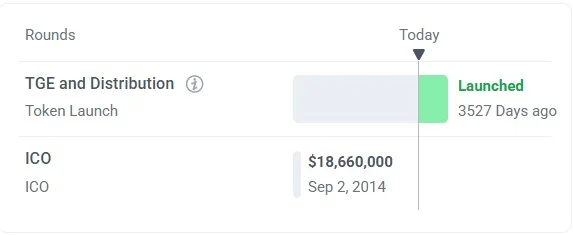
After several months of stress testing, the official public mainnet of Ethereum, Frontier, was launched on July 30, 2015. This marked the date when the Ethereum blockchain officially went live and the community began to grow. Before Frontier, Vinay Gupta and Stephen Taul warned developers that this first version was the “bare minimum” and urged them to proceed with caution. Frontier was a platform used via command lines, without a graphical user interface (GUI), and its capabilities were largely limited to those already familiar with Ethereum.
Ethereum History: Key Milestones
As a platform that revolutionized the cryptocurrency ecosystem, Ethereum has undergone many critical phases since its inception. Updates, community decisions, and technical improvements during this process have shaped Ethereum into what it is today. The key milestones that stand out in Ethereum's history are as follows:
- 2015 - Official launch of Ethereum (Frontier): As mentioned above, the Ethereum blockchain was officially launched on July 30, 2015, with the Frontier version. This initial phase supported smart contracts and Proof-of-Work (PoW) mining, enabling users to perform transactions and develop applications on the network. Initially, a reward of 5 ETH per block was awarded.
- 2016 - DAO attack and Ethereum-ETC split: 2016 marked an important and unplanned turning point in Ethereum's history. The Decentralized Autonomous Organization (DAO) had raised 150 million USD worth of ETH through a token sale. However, in June, the DAO was hacked, and 50 million USD worth of ETH was stolen. This incident deeply shook the Ethereum community, leading to the decision to perform a hard fork—an event that split the network into two—to recover the funds and address the security vulnerability. This hard fork sparked debates within the community, with some members continuing to operate on the original chain. The original chain, where the stolen funds were not recovered, is known as Ethereum Classic (ETC), while the majority and core developers continued to work on the forked chain (Ethereum - ETH), where the stolen ETH was returned to its original owners.
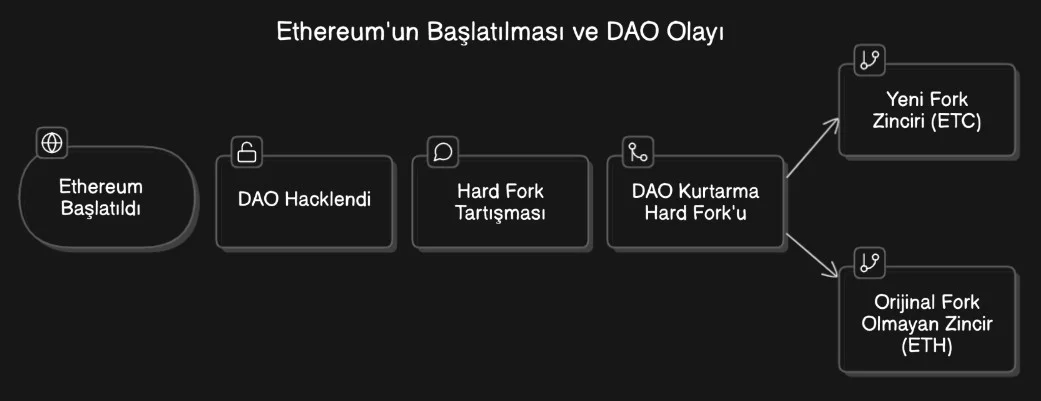
- 2017 - ICO boom and Ethereum's growth: Between 2017 and 2018, there was an Initial Coin Offering (ICO) boom, and Ethereum played a central role in this process. Ethereum's smart contract functionality enabled developers to easily create new tokens and launch protocols, leading to most ICOs taking place on the Ethereum network. The ERC-20 token standard gained widespread adoption during this period, further solidifying Ethereum's importance within the crypto ecosystem. This increased usage led to a rapid rise in the value of Ether, Ethereum's native token.
- 2020: Ethereum 2.0 and the transition to Proof of Stake: A significant step toward Ethereum's future was the announcement of the Ethereum 2.0 (also known as Serenity) roadmap. This involved a series of upgrades aimed at transitioning Ethereum's consensus mechanism from Proof-of-Work (PoW) to Proof of Stake (PoS), which is more scalable, secure, and energy-efficient. This transition was planned in phases, with the first major step taken in 2020 with the launch of the Beacon Chain. The Beacon Chain introduced PoS consensus but initially operated in parallel with the existing PoW chain.
- 2022 - Full transition to Proof of Stake with The Merge: The latest answer to the question “How does Ethereum work?” came with the completion of The Merge. Ethereum's full transition to PoS was completed with the historic event known as The Merge, which took place on September 15, 2022. This merger signified the integration of the original Ethereum Mainnet (transaction layer) with the Beacon Chain (consensus layer), marking the end of PoW mining. The network transitioned to Proof of Stake, an energy-efficient consensus mechanism where validators are selected based on the amount of cryptocurrency they hold. The Ethereum Merge reduced energy consumption by approximately 99.95% and laid the groundwork for future scalability upgrades. The term ‘Eth2’ has been discontinued, and the network now operates as a single Ethereum chain.
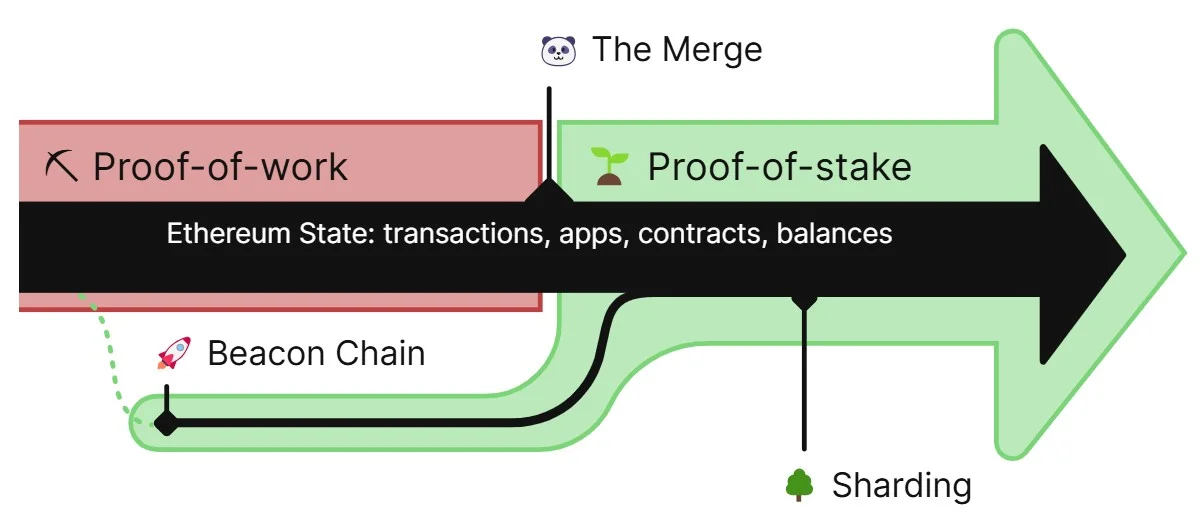
With all these developments, Ethereum made its mark on the blockchain space. In particular, by transitioning from Proof of Work (PoW) to Proof of Stake (PoS), it aimed to address issues such as energy efficiency, scalability, accessibility, decentralization, and long-term sustainability. While PoW's high energy consumption and mining requirements led to environmental and economic issues, PoS significantly reduced energy usage.
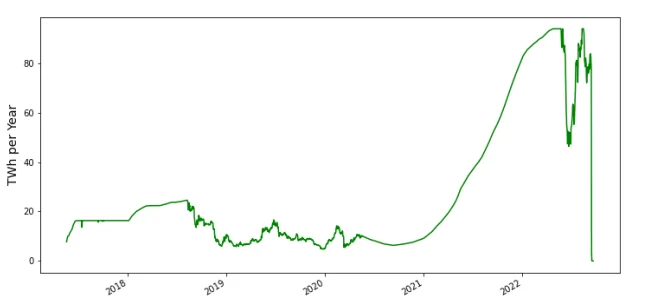
While discussing such significant milestones, it is impossible to overlook Ethereum's price movements. The cryptocurrency giant has experienced a highly volatile 10-year market journey. Ethereum's price has seen significant fluctuations since its launch in 2015. Initially, it traded below $1 in 2015. In 2017, it surpassed $100 and reached approximately $774 by the end of the year. In November 2021, it reached an all-time high of approximately $4,891. However, as of April 2025, the price had dropped to approximately $1,795. Nevertheless, market data shows that Ethereum has seen an increase of approximately 179,400% from 2015 to 2025. As can be seen in the 10-year price chart below, the largest price jumps occurred in 2017 and 2021.
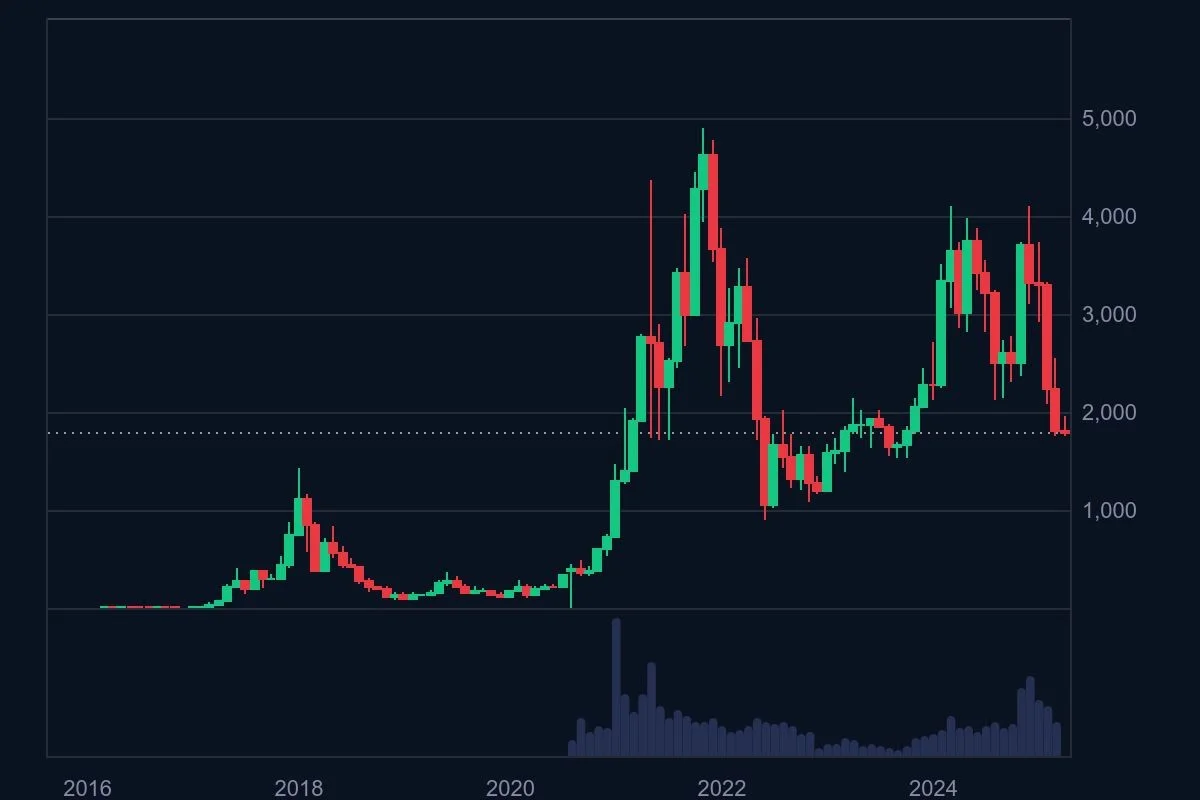
Why is Ethereum Important?
So, why is Ethereum important in the field of cryptocurrency and blockchain? Ethereum is not just a cryptocurrency, but has also become an ecosystem that forms the basis for innovative technologies such as decentralized finance (DeFi), NFTs, and smart contracts.
It has brought major innovations with smart contracts. Ethereum's greatest significance lies in popularizing the concept of smart contracts and providing developers with the opportunity to build various applications using this technology. Unlike traditional contracts, smart contracts are agreements that are automatically executed when predefined conditions are met, without the need for any intermediaries. This enables transactions to occur in a more transparent, secure, and efficient manner and opens up new use cases across various industries. Thanks to Ethereum's Turing-complete programming language, developers can create smart contracts and applications of nearly unlimited complexity.
It has enabled the emergence of decentralized finance (DeFi) and the NFT ecosystem. Ethereum has played a vital role in the birth and growth of the decentralized finance (DeFi) ecosystem. DeFi refers to financial services that operate on the blockchain without the need for traditional financial intermediaries (such as banks). Ethereum's smart contract capabilities have enabled the development of various DeFi protocols, including decentralized exchanges (DEXs), lending and borrowing platforms, yield farming, and stablecoins.
Similarly, the Non-Fungible Token (NFT) ecosystem has also developed largely on Ethereum. NFTs are indivisible tokens that represent ownership of unique digital or physical assets such as artworks, music, virtual land, and collectibles. Ethereum's ERC-721 and ERC-1155 token standards are widely used for creating and trading NFTs. NFTs have opened up new opportunities in the creative economy and redefined the concept of digital ownership.
It has become an open-source blockchain for developers. As an open-source project, Ethereum is accessible and transparent to developers worldwide. This enables a broad developer community to contribute to the platform, develop new tools, and create applications. Ethereum's Ethereum Virtual Machine (EVM) ensures that smart contracts are executed securely and consistently. Specially developed programming languages like Solidity make it easier for developers to create powerful and complex applications on Ethereum.
It has become a cornerstone of Web3. In addition to being an open-source blockchain for NFTs, DeFi, smart contracts, and developers, Ethereum is recognized as one of the cornerstones of the decentralized internet vision known as Web3. Web3 aims for an internet model where users have greater control over their data and digital identities, and the influence of central authorities is reduced. Ethereum's decentralized structure, smart contract capabilities, and extensive developer ecosystem provide an ideal foundation for the development and widespread adoption of Web3 applications. Additionally, Layer 2 scaling solutions and projects like Superchain enhance Ethereum's transaction capacity, enabling Web3 applications to reach broader audiences.
Who is the Founder of Ethereum?
So, who is Vitalik Buterin, the founder of Ethereum? Vitalik Buterin is the co-founder of Ethereum and one of the most influential figures in the cryptocurrency world. Born on January 31, 1994, in Russia, Buterin moved to Canada with his family at the age of six. Demonstrating exceptional talent in mathematics and programming from a young age, Buterin was introduced to Bitcoin at the age of 17 through his father. Impressed by Bitcoin's decentralized structure, Buterin began conducting in-depth research in this field and became one of the co-founders of Bitcoin Magazine, one of the first cryptocurrency publications, in 2011.
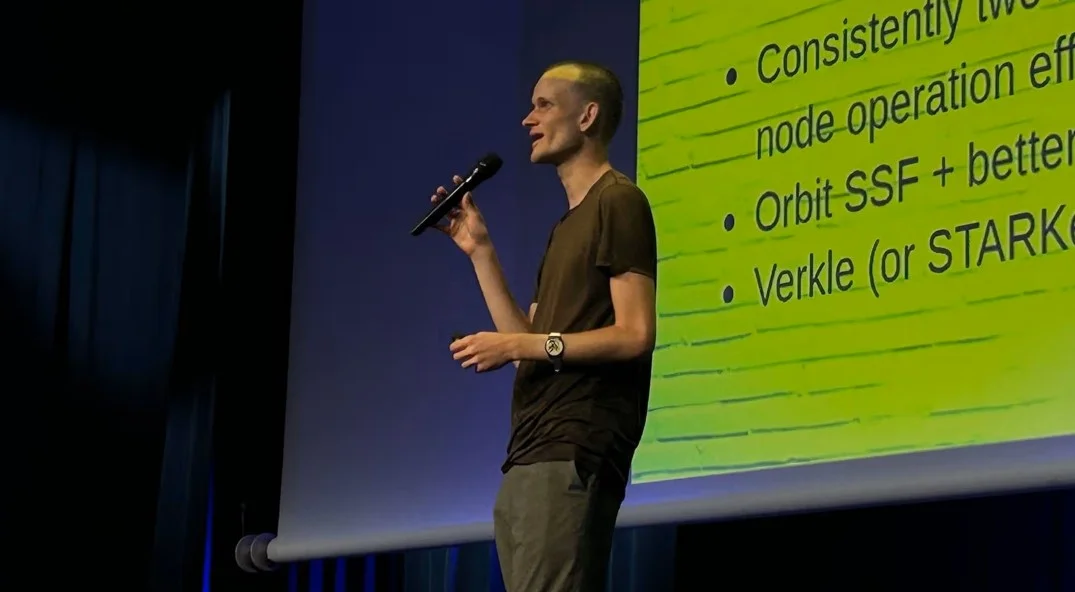
Charity Organization | Year | Cryptocurrency | Amount |
Machine Intelligence Research Institute | 2017 | ETH | $763,970 |
SENS Research Foundation | 2018 | ETH | $2.4 million |
SENS Research Foundation | 2020 | ETH | $50,000 |
India Crypto Covid Relief Fund | 2021 | SHIB | $1.14 billion |
Methuselah Foundation | 2021 | Dogelon Mars | $336 million |
Ukraine Relief Fund | 2022 | ETH | $2.5 million |
Unchain Fund | 2022 | ETH | $2.5 million |
Animal Welfare Fund | 2024 | ETH | $532,398 |
Zuitzerland | 2025 | ETH | $500,000 |
Khao Kheow Open Zoo | 2024 | USDC | $290,000 |
Source: CCN
In addition to Vitalik Buterin, the team that contributed to the development of Ethereum is also of interest. Initially, names such as Anthony Di Iorio, Charles Hoskinson, Mihai Alisie, and Amir Chetrit were involved in the development of Ethereum. Later, Joseph Lubin, Gavin Wood, and Jeffrey Wilcke also joined the founding team. Gavin Wood made a significant contribution by writing the Ethereum Yellow Paper, which outlined the features of the Ethereum Virtual Machine (EVM). The development of Ethereum was carried out by Ethereum Switzerland GmbH (EthSuisse), based in Switzerland, and later by the non-profit Ethereum Foundation (Stiftung Ethereum).
Vitalik Buterin's views on blockchain and decentralized ecosystems are also noteworthy. Indeed, Vitalik Buterin has designed Ethereum from the outset not merely as a cryptocurrency but as a global infrastructure for decentralized applications and smart contracts. Buterin's vision is to create a world where individuals have greater control over their digital assets and personal data, and where decentralized applications offer greater transparency and security.
Buterin believes that Ethereum's success depends on the developer community's ability to collaborate on innovative projects. In his view, decentralization is of vital importance for the network's security, transparency, and resilience. He emphasizes that to preserve Ethereum's decentralized structure, elements such as committees or central intermediaries must be avoided.
While acknowledging that Ethereum must continue to evolve in the future, he stresses that this must be done without compromising the principle of decentralization. He states that his ultimate goal is to make Ethereum the foundational layer of a decentralized internet (Web3) and to provide individuals with greater freedom and control in the digital world.
Buterin believes that decentralization is not just a technological feature but also has social and political dimensions. In his view, Ethereum is not merely software but a structure aimed at creating an ecosystem where different actors can collaborate more efficiently and resist centralization pressures.
In conclusion, Ethereum was born out of Vitalik Buterin's vision and revolutionized the blockchain world. It has been a pioneer in areas such as smart contracts, DeFi, and NFTs, and continues to evolve with its open-source structure. With the contributions of its community and its innovative approach, Ethereum appears poised to remain at the center of the blockchain ecosystem in the future.
For more content on Ethereum and blockchain technology, follow the JR Kripto Guide series.